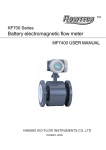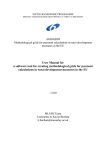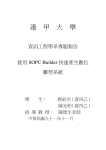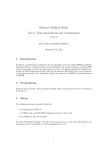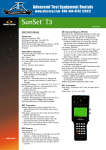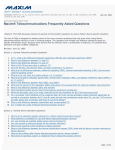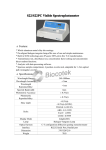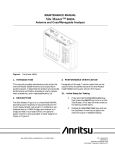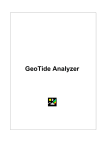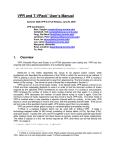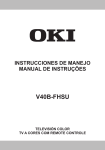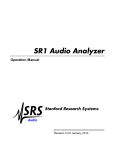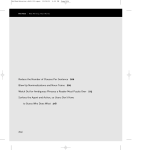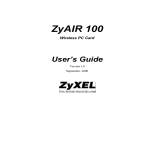Download Secure-T
Transcript
EE 552 Secure-T Final Report Ian Kuon - [email protected] Mark Calder - [email protected] November 27, 2000 Declaration of Original Content The design elements of this project and report are entirely the original work of the authors except as follows: • 3-Way encryption algorithm was taken from Applied Cryptography [2] • External Circuitry for LIU taken from CS63130 data sheet [5] • Clock Divider Circuit taken from Student Application Note [11] • The general model for the test bench has been taken from Lab 5 [12] and a student application note [13] • Source Code for 3-way encryption and cipher feedback mode operation taken from Mcrypt[14] ____________________________ Ian Kuon Date Ian Kuon Mark Calder ____________________________ Mark Calder Date Secure-T Page 2 of 54 Abstract This project is an undertaking to create a full duplex combination encryption device and DS1 framer. The hardware receives the combined output from the 24 channels, encrypts this data using the 3-Way encryption algorithm in Cipher Feedback Mode (CFB), assembles it into DS1 193S frame format, and then outputs this to a standard Line Interface Unit (LIU) T1 interface chip, the CS61310. This data could then be securely transmitted across any T1 line and the user at the other end could then use another similar device to receive the data and decrypt it, provided they are aware of the key. The project has been fully simulated and the results from simulation have been compared to output from C/C++ programs that implement these algorithms. The successful design was implemented on an Altera 10K20 FPGA found on an Altera UP1 board. This system was tested to verify complete functionality and the design was found to operate correctly. The framing was found to be compliant by both a Super T1 ISA card and a TauTron DS1 tester. Frame synchronization could also be found with these sources. The encryption and decryption routines were also successfully implemented. Ian Kuon Mark Calder Secure-T Page 3 of 54 Table of Contents Declaration of Original Content..................................................................................... 2 Abstract .......................................................................................................................... 3 Table of Contents ........................................................................................................... 4 Table of Figures ............................................................................................................. 6 Achievements.................................................................................................................. 7 Product Applications ...................................................................................................... 9 Description of Operation .............................................................................................. 10 Secure-T ...............................................................................................................................10 Encrypter .............................................................................................................................10 DS1 Framer ..........................................................................................................................12 Control Module ....................................................................................................................13 Clock Divider .......................................................................................................................15 Design and Testing....................................................................................................... 16 Design Hierarchy .................................................................................................................16 Resource Requirements .......................................................................................................17 Design Implementation Decisions/Investigations ................................................................17 Framing...........................................................................................................................................17 Frame Synchronization (Deframe)....................................................................................................17 Encryption/Decryption.....................................................................................................................19 Timing Investigations ......................................................................................................................19 Design Verification...............................................................................................................20 Testing Strategy for Frame Block .....................................................................................................20 Testing Strategy for Deframe Block .................................................................................................20 Testing Strategy for Encryption/Decryption......................................................................................21 Testing Strategy for Entire Secure-T Design.....................................................................................21 IC Characterization Results ......................................................................................... 23 Interface Testing ..................................................................................................................23 Functional Testing................................................................................................................23 References .................................................................................................................... 25 Appendix A – Product Data Sheet ................................................................................ 26 Part No. IM5434........................................................................................................... 27 Appendix B - LIU Datasheet ........................................................................................ 31 Appendix C - Frame Synchronization Algorithm......................................................... 34 Ian Kuon Mark Calder Secure-T Page 4 of 54 Appendix D - Parts List ................................................................................................ 36 Appendix E - Simulation Results.................................................................................. 37 Test Case Index ....................................................................................................................37 Appendix F - Test Benches........................................................................................... 47 Appendix G - VHDL for Design ................................................................................... 48 Appendix H - C/C++ Source Code for Test benches .................................................... 50 Ian Kuon Mark Calder Secure-T Page 5 of 54 Table of Figures Figure 1 Duplex Mode.............................................................................................................................. 9 Figure 2 Single Operation Mode............................................................................................................... 9 Figure 3 Overview of Secure-T Structure .................................................................................................10 Figure 4 CFB Encryption ........................................................................................................................12 Figure 4 DS1 Framing Structure .............................................................................................................13 Figure 5 Secure-T State Machine.............................................................................................................14 Figure 6 Design Heirarchy......................................................................................................................16 Figure 7 Hardware Schematic .................................................................................................................30 Ian Kuon Mark Calder Secure-T Page 6 of 54 Achievements Framing The framing module correctly outputs DS1 frames appropriate for use with the hardware available. In simulation the correction operation was observed and this was confirmed in hardware as both the DS1 tester and the Super T1 ISA card were able to find frame synchronization with the output stream. This was accomplished despite a late change in the framing format. It had been thought that the DS1 tester used DS1 frames since it was not otherwise specified in the user manual; however, it was later determined that in fact 193S frames are used. This necessitated the late change to the newer frame format. Two designs were made and tested for both original DS1 framing and Superframe D4 193S frames; however, only the final 193S frame format was implemented on the chip since the test equipment available is only able to work with this format. The proper functioning of the framing module is a significant accomplishment since this exceeds the intended goal of only implementing DS1 frames. Frame Synchronization The deframe module can find the frame bit of an incoming DS1 data stream and then mark the frame bits with a signal. As such, it obtains synchronization with the incoming data which allows operations such as encryption and decryption to be performed on the data while not altering the framing structure. It can also pass the data through directly without altering. As with the frame module the format was modified to 193S frames after problems were discovered in communicating with the hardware. Thus two fully functional modules with DS1 and D4 193S frames were implemented. Frame synchronization is no simple feat and it is a considerable accomplishment to design a system that can successfully find frame synchronization with a pseudo-random data stream. Simulation verified the correct operation of this block and the hardware tests supported this. The algorithm for frame synchronization is also noteworthy as it was developed by the group. It provides quick and reasonably accurate detection of framed signals while using a low number of logic cells and only a third of the ram on the chip. Encryption/Decryption A hardware design of the Three Way Encryption Algorithm in Cipher Feedback Mode (CFB) was successfully completed. Simulation verified the output is correct by comparing the output from a pseudo random stream of data to the expected output from publicly available source code. This output could also be successfully decrypted. The CFB operates in 1 bit block mode which allows synchronization without any alignment signals. This is a powerful and required feature for a communications line since alignment signals may not always be present as in the case of unframed data. The VHDL implementation of the Cipher Feedback mode is flexible in that a different block cipher could be used as a drop in replacement for the 3-way algorithm. Ian Kuon Mark Calder Secure-T Page 7 of 54 Space and time constraints prevented the design from implementing the typical 11 rounds of the algorithm. The author of the algorithm allowed for any number of rounds; thus, it was decided that one round would be implemented. It had been desired to allow for arbitrary size Cipher Feedback Mode Encryption; however, size constraints prevented this from being completed and tested. As with the encryption, the publicly available Three Way Encryption algorithm was implemented for decryption. Decryption was successfully implemented in a similar manner to encryption. The two blocks were successfully combined and fit to a usable size within the chip using 359 logic cells. This is a significant reduction from the number of blocks required for 8 bit CFB which exceeded the blocks available on the 10K20. Secure-T The blocks were successfully combined on a single Altera 10K20 device. Simulation was successfully completed and it has been verified that the device functions correctly. The design has also been successfully implemented in hardware on the UP1 board. The device communicates with the T1 LIU on a separate board and is able to transmit and receive data in full duplex operation. It had been desired to include a method for entering the encryption key into the device once programmed (during operation). With a 96 bit key, this is an arduous task using switches and it was not possible to incorporate another interface to the chip such as a key pad which would have made the task easier. Instead the key is determined when the device is programmed. It can be easily changed via a single constant. This change has the additional benefit that it prevents accidental altering of the key since it is unlikely that the key will be changed while the device is in operation. Ian Kuon Mark Calder Secure-T Page 8 of 54 Product Applications With the trend towards greater reliance on telecommunication for all corporate and personal information, there is increasing concern about the security of this data. Therefore, it is becoming more important that any voice or data transmissions be encrypted to ensure that private data is only revealed to the “proper” parties. While encryption does not guarantee that the data will not be compromised, it does reduce the possibility of this occurring. The solution to this privacy problem is the Secure-T, an innovative combined encrypter and DS1 framer. This allows the traffic for an entire office that connects via a T1 line to be secured. With the modern phone system one is never certain of the route the traffic will take and this solution ensures that the data will not be compromised as easily. At the other end of the line, another branch office can use another Secure-T chip or a possible software solution, to decrypt the data, provided they know the appropriate information. This versatile chip has many possible modes of operation. The digital side interface allows the chip to be operated in full duplex mode transmitting and receiving data while encrypting and decrypting as appropriate. Backplane Data Secure-T Cable / Transmission Network T1 LIU Figure 1 Duplex Mode Another interesting mode of operation allows the device to be patched into a T1 line to encrypt or decrypt the data in a single direction. This allows this product to be used without any modification to existing boards. Encryption or Decryption T1 Line T1 LIU RX Secure-T T1 LIU TX T1 Line Figure 2 Single Operation Mode Ian Kuon Mark Calder Secure-T Page 9 of 54 Description of Operation The general structure of the chip is given in Figure 3. Switches/ Buttons/ LEDs User Control Backplane Data, Frame Pulse and Clock Encrypter RAM Interface T1 Framer Controller LIU Control Data/Clock to and from LIU 1.544 MHz Clock Divider Clock 24.704 MHz Figure 3 Overview of Secure-T Structure Secure-T The top level entity provides the external connections along with the internal interconnections. It allows for routing of the data based on the user selection of switches on the UP1 board. This also produces the necessary clock and clock enable signals for the blocks. Data is transmitted along with a clock in order for it to be correctly read in; thus the function of Secure-T is to synchronize that clock with the appropriate internal signals. Encrypter Encryption can be performed on the data to ensure that it is safely transmitted across communication lines. Similarly decryption can be performed on the incoming data. There are various algorithms available that perform encryption on binary data.1 The algorithm selected for this application is 3-Way. It is an unpatented algorithm specifically designed to be hardware efficient and it provides more security than the Data Encryption Standard (DES). It was selected over other algorithms such as IDEA because 1 Encryption or Decryption is accomplished by performing logical operations or permutations on the data stream so that the output no longer appears to be related to the input stream. For an in depth discussion of encryption techniques and reasons for performing encryption refer to Applied Cryptography [2]. Ian Kuon Mark Calder Secure-T Page 10 of 54 of space constraints on the chip. It was required to select an algorithm that did not require look up tables since the RAM on the chip was reserved for use with the frame and frame synchronization procedures. The algorithm has been publicly available since 1995 and has had no known successful cryptoanalysis against it.2 The 3-way algorithm that is implemented in this block is as follows For i = 0 to n -1 x = x ⊕ Ki x = theta (x) x = pi -1 (x) x = gamma (x) x = pi - 2 (x) x = x ⊕ Kn x = theta (x) where n is the number of rounds theta (x) is a linear substitution function pi-1 (x) and pi-2 (x) are permutations gamma(x) is a non linear substitution function3 The bit order of the data must be reversed for decryption; however, because Cipher Feedback will be used as discussed below, it will not be necessary to perform decryption and the block cipher itself will always be used in encryption mode. This block will implement the encryption using the Cipher Feedback Mode (CFB) which will effectively make this algorithm behave as a self synchronizing stream cipher. Selfsynchronization is important to this application since there might be no other way to synchronize the codes and correctly decrypt the information. An overview of CFB mode is given in the diagram below. Decryption in CFB mode is accomplished by changing the positions of the plain text and the cipher text in the XOR operation. The cipher text is used in the register. 2 3 Schneier, Bruce. Applied Cryptography. John Wiley & Sons Inc. Pg. 342 Schneier, Bruce. Applied Cryptography. John Wiley & Sons Inc. Pg. 342 Ian Kuon Mark Calder Secure-T Page 11 of 54 Last 12 bytes 3-Way Encryption Key 96 bit cipher outputi Least Significant Block of Cipher Text plaintexti ciphertexti Figure 4 CFB Encryption4 This approach requires an initialization vector (IV). This code is only required at the start of each message. Since the T1 data is a continuous stream of data this must only be performed once on power up. The device can then continue operating indefinitely without an IV. This same IV is used for decryption and encryption. Since the IV is essentially not required except for power up, it was decided that a single constant IV would be used. While in theory, the IV should be unique, it was not considered significant enough to warrant the significant additional logic this would have required. Furthermore, synchronization of the IV between encryption and decryption at the two ends of a T1 line would prove to be difficult. If frequent power cycling occurs, making the weak IV a concern, a future version of the device could allow for a random IV. Although, without synchronization this will mean that the first 96 bits will be lost. With data transmission there is a the potential for bit errors. When they occur a single bit error will impact the following 96 bits as well due to the CFB mode of operation. While this is a significant loss, the requirement for self synchronization forced the choice of this mode. DS1 Framer A frame is a large data structure that contains signaling and data bits so that the data may be properly handled. For this design the DS1 frame format, which runs at a speed of 1.544 Mbit/s and is widely used for network communication among offices, will be used. The T1 carrier frame that will be implemented is the North American version using 24 channels as opposed to the 32 channels used by the European version. Framing is 4 Schneier, Bruce. Applied Cryptography. John Wiley & Sons Inc. Pg. 200 Ian Kuon Mark Calder Secure-T Page 12 of 54 required in order to preserve the alignment of these different channels so that the individual channels can be processed as required. The encrypted data will be passed to the framer which will put the data in the appropriate format. The framer will also be capable of taking framed data and synchronizing with it so that each of the channels can be properly identified. There are numerous types of framing DS1 structures possible. The simplest format is DS1 framing. For this format the 24 channels, with 8 bits each, are combined in the T1 line and a framing bit is inserted at the beginning, giving a total of 193 bits per frame. The framing bit alternates between 0 and 1 to ensure frame alignment. Some implementations use data robbing whereby some data bits are used for signally; however, this framer will not use bit robbing to send control information as this chip is intended to be used with data as well. Frame 1 Bit Channel 1 8 bits Channel 2 8 bits Channel 3 8 bits … Channel 24 8 bits Figure 4 DS1 Framing Structure5 This design was successfully implemented; however, it was decided that to increase the versatility of the device, the more commonly used D4193S Super Frame Format would be used. This structure groups the single DS1 frames into a 12 Frame structure known as a super frame. The following bit pattern is then used in the frame bits. "100011011100".6 The framing process for the data is fairly straightforward; however, the algorithm for frame synchronization is more complex. Frame synchronization will be found using a parallel algorithm. It stores the first frame received and compares each of the bits in this frame to the next frames until only one possible candidate for the frame bit remains. A synchronization signal is produced to indicate that alignment has been found correctly. Frame pulses are then produced to indicate the position of the frame bit in the data stream. For a detailed overview of the algorithm that will be used please refer to Appendix C. Control Module The user will be able to interface with the chip using the switches and push buttons. There will be a reset button that will put the chip in its initial operating mode. The status of the chip will be shown using various LEDs. The Secure-T has full duplex functionality allowing data to be encrypted and framed at the same time as decryption and frame synchronization is occurring. The following state machine provides an overview of the operation of the machine. 5 Fort Hays State University. INT 478 B Datacom Chapter 8. Internet. 2000. http://int.fhsu.edu/kevin/courses/datacom1/html/chapter_8.html 6 Super-T1 Card User's Guide. GL Communications. Pg A-1. Ian Kuon Mark Calder Secure-T Page 13 of 54 Reset=0 Reset Switch=0 Enter=0 Normal Switch=1 Enter=0 Switch=2 Enter=0 Debug _All1 Debug_Loop Figure 5 Secure-T State Machine The current state will be indicated on the LEDs as follows. Reset - Reset State “0” All1's “1” Normal - Behavior based on switches “2” Debug Loopback “3” Error “8” In the normal operation mode, the device can be controlled using the switches available on the UP1 board. Switches 1 and 2 are reserved for testing and the functions of Switches 3 through 7 are given below. Changes made on the switches take place asynchronously and do not require any additional button presses. This design decision was made since in normal operation the mode of operation will not be altered frequently; therefore, it was not warranted to design a more complex state machine. The following table describes operation of the switches while in normal mode. Switch Control_Bit Description 1 0 Debug Mode –All1 – Active Low 2 1 Debug Mode – Device Loopback – Active Low 3 2 Encrypt – Active High 4 3 Decrypt – Active High 5 4 Frame – Active High 6 5 Deframe – Active High 7 6 Loopback – Active High 8 7 Reserved Ian Kuon Mark Calder Secure-T Page 14 of 54 Clock Divider T1 protocol operates at a speed of 1.544 Mbit/s; thus it will be necessary to have a clock of this frequency available so that the data can be properly output. As well, the LIU requires a T1 speed clock for it to function correctly. However, for many operations, in particular the encryption and frame synchronization blocks, it will be desirable to have a higher speed clock and thus, a higher speed will be given to the chip. This block divides the device clock (24.704 MHz) by 16 to produce a T1 speed (1.544 MHz) signal. An enable signal is also provided for internal blocks. The enable signal only pulses high for 1 clock cycle. Ian Kuon Mark Calder Secure-T Page 15 of 54 Design and Testing Design Hierarchy Figure 6 Design Heirarchy The VHDL Source files can be found in Appendix G Ian Kuon Mark Calder Secure-T Page 16 of 54 Resource Requirements Summary of Logic Cells Required Logic Cells Required frame 279 deframe 154 compare 107 frameblock 428 cfb_encrypt 178 cfb_decrypt 180 encrypt 359 divide_clock 7 Total for Secure-T 798/1152 EABs 2 2 2 4 0 0 0 0 4/6 Max Clock Frequency 24.05 MHz 35.46 MHz 36.63 MHz 30.00 MHz 25.64 MHz 103.9 MHz 29.67 MHz 113.63 MHz 24.03 MHz Note: The number of logic cells do not sum to the total number of Logic Cells since both the low level blocks and the upper level blocks that instantiate them are listed. Design Implementation Decisions/Investigations Framing Originally the simple DS1 framing pattern was to be used for this project. However, the test equipment available (T1 interface card), did not support this format, which involved a simple alternating 1 and 0 frame bit pattern. Thus, it was necessary to implement a more complicated format supported by the card, the 193S format. This format involves combining 12 frames together into a super frame. Thus the framing module needed considerable adjustments, the frame bit would no longer be simply an alternating pattern of 1s and 0s, but rather a repeating pattern of a string of 12. There were two main options for implementing this change. The first involved using a lpm_shiftreg entity to rotate between the possible frame bits. However, it was felt that this solution introduced unnecessary complexity for a single bit operation. Thus, the second option was used which involved a case statement operated by a simple counter. The excellent speed response of case statements also made this a wise choice, although there was a certain amount of trade off for the extra space of the counter. Frame Synchronization (Deframe) The change to D4 193S format mentioned above also affected the deframing procedure. The search procedure could no longer simply look for an alternating bit pattern in 193 bit intervals, because that was no longer a valid criterion. The solution implemented was to check for the same alternating pattern every 386 bits, as this is true in 193S DS1. In such a way, our original code could be used with limited modifications. The cost associated with this choice was an increased search time (approximately double) and a larger area since more frames had to be stored and eliminated from contention as a frame bit. Ian Kuon Mark Calder Secure-T Page 17 of 54 The frame synchronization algorithm used a parallel frame bit search strategy, as opposed to a serial strategy (for more details on the frame synchronization algorithm see Appendix C). The parallel scheme involves looking at every bit as it enters and determining if it is an eligible frame bit. When only one bit is left eligible, the frame bit is found. A serial search scheme would involve looking at a particular bit index within the frame until that bit did not fit the framing convention, then moving to the next bit. If a bit kept framing convention for a set period of time it would be found to be the frame bit. The advantage to this scheme is it can be implemented in less logic cells, as one does not need to store the current eligibility of each of the bits. However, in the average case it is far slower than the parallel algorithm, since several frames of data may pass by as each non-frame bit is cycled through. It also leads to a greater chance of error if a random data bit follows framing convention for a period of time. Thus, the parallel scheme was used. To deal with the greater storage size, a RAM block (implemented with EAB’s) was used to keep track of the eligibility of each block. In order to minimize chip area (logic cell count) it was determined that storage of the vectors required for determining frame synchronization would be done using RAM. Numerous different trials have been performed using the LPM modules for the interface to RAM. First the design was implemented using the lpm_ram_dp modules; however, compiling this approach indicated that no EAB's (i.e. no RAM) was being used and instead it was implemented in logic cells which led to an excessively large design. The Dual Port module had the functionality desired however, this implementation with Logic Cells was not acceptable. The design has therefore been changed to use lpm_ram_dq. The 193 check bits stored in RAM and used in the Compare module was implemented using lpm_ram_dq instead of lpm_fifo. Initially it was desired to implement using lpm_fifo, as this would allow us to both pull a value from RAM and store a new value in RAM simultaneously. However, implementing with lpm_fifo led to the total logic cells used (at the time) to increase from around 225 to 550, and the number of EABs to increase to 3. By pulling from the RAM during the first half of the clock cycle, and inserting in the second half of the clock cycle we managed to attain the same functionality of the lpm_fifo with the lpm_ram_dq. Initially the deframe module used a lpm_fifo structure to store data when the chip was attempting to find synchronisation with the input stream. This data could then be output with the frame bit correctly identified once the synchronisation has been found. However, this structure used 2 EABs and a large number (roughly 150 logic cells) to implement. Also, the size of the lpm_fifo component would have to be fairly large to store all of the necessary data (in an average case it would take 9 frames of data or 3474 bits to identify the frame bit)7. For these reasons, it was decided to simply pass through the beginning frames of data until synchronisation is found. 7 The average case is calculated with the assumption that half of the bits will be eliminated from frame bit eligibility each frame. Hence, one will need log2(386) frames, or approximately 9 frames of size 386 bits. Ian Kuon Mark Calder Secure-T Page 18 of 54 Encryption/Decryption The encryption algorithm was initially implemented and found to be too large for the intended device, requiring almost 1000 logic cells, leaving nothing for any other functions. To remedy this problem, the CFB block size was varied. This was found to have a significant effect on the size of the implementation. Therefore, it was decided that a 1 bit block will be used. This gives the greatest flexibility for a self-synchronizing stream cipher as there is no alignment that must be determined. Initially, the intent was for an 8 bit CFB (1 byte) block which would have allowed for easy comparison with standard available CFB encryption libraries such as Mcrypt. Unfortunately this change meant that slight modifications to the standard encryption schemes were required. This is not a significant problem as the data is still adequately encrypted and can be decrypted by a software algorithm or another Secure-T device. It had been initially desired to vary the number of rounds used in the encryption process; however, this proved difficult to accomplish in the allotted time. As well it was feared that such a modification would increase the size of the design beyond the capacity of the chip. Therefore it was decided to have the design only perform one round of encryption. While the impact of this change to the security of the algorithm is unknown, it was considered worthwhile given the savings in area and design time it provided. While the encryption routines all passed in the test bench simulations, it was found later during top level simulations that a timing problem in the CFB encryption routine prevented data from being transmitted to the other blocks in the chip. This problem was corrected by adding a register on the outputs from the encryption and decryption blocks. Once this correction was implemented all the blocks simulated correctly. Timing Investigations In combining the various blocks (frameblock and encrypt) it was realised that it would be necessary to minimize any timing delays as the design is relatively large. One approach used to accomplish this was the use of ranges on any natural or integer signals in the design. During the initial design phases all the integers and naturals were left with default ranges and this was found to produce blocks with relatively slow minimum clock periods. In particular the framing block was found to improve from a maximum clock frequency of 12.67 MHz to 23.75 MHz when the range of values was limited to the actual required range. This speed up was significant since it allowed the frame block to operate at full speed. The interconnection of the blocks in the Secure-T entity was considered low risk; however, after completion it was found that the timing constraints of the large design prevented it from operating correctly according to the Timing Analyzer of Maxplus2. Numerous errors similar to the following were found to occur Error: Delay path from '|encrypt:encrypt_Block|Tway_cfb_encrypt:encryption_d evice|LPM_SHIFTREG:output_shift_reg|dffs74.q' to '|encrypt:encrypt_block|Tway_cfb_encrypt:encryption_d evice|LPM_SHIFTREG:output_shift_reg|dffs74.Q' Ian Kuon Mark Calder Secure-T Page 19 of 54 is 5.1ns but Clock skew is 3.5 ns and hold time required for '|encrypt:encrypt_block|Tway_cfb_encrypt:encryption_d evice|LPM_SHIFTREG:output_shift_reg|dffs75.Q' is 1.6ns -- circuit cannot operate because Clock skew plus hold time of destination register exceeds register-to-register delay This was despite the fact that all the blocks had been successfully checked as they were designed. To resolve this problem varying the Speed vs. Area slider was attempted which was able to remove some of the areas; however, errors still occurred and slight changes in any logic caused the location of these errors to move preventing one from specifying a specific timing constraint. A newer version of Maxplus2 was used without success at solving this problem. It was eventually found that a fixing a minor bug in one of the blocks removed this error; however, the reason for this is not clear as the change was not on one of the erroneous blocks. This error is a significant concern and should it occur again it is unknown what can be done to eliminate it. Design Verification The strategies that were used for testing are discussed below. The simulated waveforms and the output from the test benches that verify these tests pass can be found in the Appendix. Testing Strategy for Frame Block A test bench was used to ensure the correct operation of the framing block. It read input values from an input file along with the expected output. This expected output was then compared to the actual data produced by the frame block. The values in the input files were generated by a C program that produces data testing several cases using pseudorandom data. The C program will produce the correct framed results and output both these and the inputs to files. Listed below are the cases that were tested: • • • Base Case #1: Data is all zeros. The output data should also be all zeros with the exception of a varying frame bit every 193 bits. Base Case #2: Data is all ones. The output data should also be all ones with the exception of a varying frame bit every 193 bits. Case #3: Random data. This data will be generated using the rand function. The output should preserve the input data with the correct alternating frame bits every 193 bits. The successful passing of these tests indicates that the frame block functions correctly. Testing Strategy for Deframe Block Ian Kuon Mark Calder Secure-T Page 20 of 54 A similar procedure to that used for the Frame Block was used. A test bench once again read input and output values from files to ascertain correct operation. Once again a C program was used to produce these input and output files. Listed below are the cases that were tested: • • • • • Base Case #1: Data is all zeros except for frame bits. The output data should be all zeros. Base Case #2: Data is all ones except for frame bits. The output data should be all ones. Random Case: Data will be produced using the rand function. This will simulate the average case. Worst Case: Data will be picked so as all bits follow the T1 format for a relatively large amount of time. This is the most difficult for the deframe block to detect. Error Case: Data that does not include an accurate frame bit will be produced. The deframe block should detect the error and produce an error message before resetting. Frame synchronization should again be found once the correct data is again passed These cases should prove sufficient to satisfy in terms of correct deframe block operation. Testing Strategy for Encryption/Decryption As there are standard C programs available that perform the encryption and decryption algorithms these programs were used on pseudo random data to generate a data stream that can be compared to the output of the Encryption and Decryption blocks. The tests were performed on various key combinations. Any deviations from expected results were flagged with a test bench. Given the length of the simulation time, waveform simulation is not particularly informative. Instead, the VHDL for the test bench has been included as well as the C code for generating the data. A sample page from the test bench output can be found in the Appendices. The basic 3 way cipher block was tested independently as well to ensure that this implementation is correct since it is critical to the operation of all the other blocks. This can only be done on a select few cases as it was found that the test bench conversion procedures are not capable of handling 96 bit vectors. Thus, this is done manually in Mentor Graphics. Testing Strategy for Entire Secure-T Design A test bench will be used to ensure the correct operation of the entire chip. The data from the chip will be compared to the expected data which will be taken from standard or custom C programs. The chip will be tested in the following modes • No encryption - verifies correct operation of the frame/deframe circuitry • Encryption with Framing - verifies correct operation of the frame and encrypt Ian Kuon Mark Calder Secure-T Page 21 of 54 • Decryption with Frame Synchronization - verifies correct operation of deframe and decrypt. A complete listing of the test cases along with the sample output waveforms or test bench data can be found in the Appendices. Ian Kuon Mark Calder Secure-T Page 22 of 54 IC Characterization Results Interface Testing For testing the functionality of the T1 LIU, two debug modes allow the Secure-T chip to force the T1 LIU into all 1's(TAOS) or remote loopback (RLOOP) mode. Testing of this stage was considered complete when there are no bit errors in loopback mode using the DS1 Tester. This test has been successfully completed. Framed and Unframed data of any type were successfully looped through the CS61310. Loopback through the Secure-T was then performed with limited success. Inconsistencies in the operation of the Line Interface unit caused some significant problems. Investigation has revealed that in some circumstances not specified in the Data sheet the device enters a Receiver Power Off mode. In this state the receiver outputs no data making testing difficult. Technical support for Cirrus Logic (the manufacturer of the LIU) has been contacted; however, no suitable advice has been obtained. It has been possible to get the receiver to function in some cases and on those occasions loopback through the Secure-T occurred; however, some bit errors were found to occur. This is likely due to noise on the board and in between the UP1 board and the T1 LIU. These bit errors are a concern and the wires will be made as short as possible in an attempt to minimize this. However, since the general operation is confirmed, this test will be considered a pass Functional Testing DS1 Framing The framing will be tested via the Super T1 ISA card and the DS1 Data generator. Sending an all 1’s data pattern into the Secure-T yielded an output to the LIU (on LIU_data_tx) that was high except for occasional low pulses that are frame pulses. The correct frame formatting was confirmed by sending this data into the T1 ISA card in Monitor mode. This mode checks for any errors in the data received by the card. Over an extended period of time no bit errors were observed and frame synchronization was maintained. On four separate occasions over a period of ½ hour, fewer than 5 frame bit errors were observed. This successfully proves that the design of frame is correct. For completeness this should be tested on multiple patterns; however, the SecureT lacks a data generator for performing this test. A future version of this device may include this feature; however, based on the design of the frame module, it is highly unlikely that the contents of the data will impact the frame transmission. Therefore, the operation of frame can be considered correct. Encryption/Decryption The encryption algorithm was tested by sourcing all 1’s data into the dig_data_in. This all ones pattern was encrypted and captured on the PC using the ISA card. Ian Kuon Mark Calder Secure-T Page 23 of 54 Unfortunately, the format of the file is not readable by any common utilities and therefore this could not be properly verified. The output data is clearly being altered from the all 1’s pattern so it is obvious that the encryption is somewhat functional. Since the simulation demonstrated that encrypt functions correctly and there were no critical timing problems in this module, one can be reasonably assured that the functionality is correct on the chip. Therefore, this encryption implementation will be considered to be a conditional pass. The decryption routine was tested in a similar manner except the chip was set in loopback mode. Again the inability to read the file has prevented the gathering of conclusive evidence that the decryption is fully functional. The algorithm was correct in simulation, though, and thus this test will be given a conditional pass. Frame Synchronization The Frame Synchronization routine was verified using the DS1 tester and the Super T1 Card. First it was verified that frame synchronization could be found with e 193S framed stream of data. Once frame synchronization was found it was indicated via an LED. This was found to occur in some occasions; however, the difficulties with the T1 LIU receiver made conclusive tests difficult. The LED was found to light up in response to framed data and once the source is removed the light would turn off. This is the desired response and indicates that the deframe module can function correctly. This will be considered a conditional pass. Ian Kuon Mark Calder Secure-T Page 24 of 54 References [1] Katzan, Harry Jr. The Standard Encryption Algorithm. Petrocelli Books, 1977 United States. [2] Schneier, Bruce. Applied Cryptography Protocols, Algorithms, and Source Code in C. John Wiley & Sons Inc. 1996. Toronto. [3] Black, Uyless. Computer Networks (Protocols, Standards, and Interfaces). Prentice Hall, 1987 Englewood Cliffs, New Jersey. [5] Dallas Semiconductor. DS2148 Datasheet. Internet. 2000. http://www.dalsemi.com/datasheets/pdfs/2148.pdf [6] Fort Hays State University. INT 478 B Datacom Chapter 8. Internet. 2000. http://int.fhsu.edu/kevin/courses/datacom1/html/chapter_8.html [7] Cirrus Logic. CS61310: Long Haul T1 Line Interface Unit. Internet. 2000. http://www.cirrus.com/design/products/overview/index.cfm?ProductID=99 [8] Caplan, Stephen, et al. E-safe. Internet. 2000. http://www.ee.ualberta.ca/~elliott/ee552/projects/1998f/esafe/ [9] Au, Jodie, et al. SafeTalk. Internet. 2000. http://www.ee.ualberta.ca/~elliott/ee552/projects/1999f/SafeTalk/FinalReport.pdf [10] Dayton, Robert L. Guide to Integrating Digital Services: T1, DDS, and Voice Integrated Network Architecture. McGraw-Hill Book Company. New York, NY. 1989. [11] Leder, Daniel. Clock-Dividing using Carry-Save and Determining Carry-Save Counter Outputs. Internet. 2000. http://www.ee.ualberta.ca/~elliott/ee552/studentAppNotes/1999f/clock_divider/. [12] Koob, John and Sung, Raymond. Adder Test Bench. Internet. 2000. http://www.ee.ualberta.ca/~elliott/ee552/labs/adder_test.vhd. [13] Gunthrope, Jason, et al. TestBenches Using File I/O under VHDL. Internet. 2000. http://www.ee.ualberta.ca/~elliott/ee552/studentAppNotes/2000_w/vhdl/File_IO_Testben ching/testbench.html [14] Mavroyanopoulos, Nikos. Mcrypt. Internet. 2000. http://mcrypt.hellug.gr/ [15] Super T1 User’s Manual. GL Communications. 1995. United States. Ian Kuon Mark Calder Secure-T Page 25 of 54 Appendix A – Product Data Sheet Ian Kuon Mark Calder Secure-T Page 26 of 54 Part No. IM5434 Secure-T – Combined Encryption Device and DS1 Framer Product Data Sheet Features • Connects seamlessly to T1 Line Interface Unit CS61310 • Provides Full Duplex Cipher Feedback mode encryption and decryption using the Threeway Block Cipher Algorithm • Encryption Algorithm is self synchronizing and requires no alignment information yet will still operate correctly when frame information is provided • Finds Frame Synchronization with a 193S framed signal • Frames data according to D4 193S Superframe format. • Capable of operating in Digital Loopback mode and still providing encryption or decryption functionality • Can be set to transmits Alarm Indication Signal (AIS) or operate in loopback mode. • Requires only a single 24.704 MHz clock • State Information is provided via a 7 segment display • Frame Synchronization is indicated via an LED and will typically be found within 1 ms Description The Secure-T is a combined T1 framer and encryption device. It interfaces with a T1 line interface unit to provide full duplex transmission of recovered T1 or backplane data with unframed DS1 data and unencrypted or encrypted data. The encryption algorithm operates in single bit Cipher Feedback mode which allows self synchronization with any bit stream. Modes of Operations The Secure-T will power up in Reset “0” Mode. To ensure normal operation, clear should be pressed after power up. Normal Operation, Status “2” will begin when enter is pressed and Switches 0 and 1 are high. Once in Normal Operation Switches 2 through 7 determine the routing of the data and determined the processing of the data (i.e framed, encrypted, etc.) Switch 0 1 2 3 4 Ian Kuon Mark Calder Control Debug Must be 1 for Proper Operation Debug Must be 1 for Proper Operation Encrypt Enable – Active High Decrypt Enable – Active High Frame Enable – Active High Secure-T Page 27 of 54 5 Framing Synchronization Enable – Active High Loopback Enable – Active High Reserved for Future Use 6 7 System Wide Active Low Clear resets all the registers in the Secure-T. LED Status Display Display A B X 0 X 8 X 1 X 3 X 2 2 Status Reset Error Debug State – Not Intended for Regular Operation Debug State – Not Intended for Regular Operation Normal Operation Normal Operation – Frame Synchronization Found Pin Descriptions Pin Name clock clear enter LED_Segment_a(6 downto 0) LED_Segment_b(6 downto 0) switches(7 downto 0) dig_data_in dig_in_fp dig_in_clk dig_data_out dig_out_fp dig_out_clk liu_data_RX Ian Kuon Mark Calder Pin Pin Function Direction Number Control Signals Input 45 System Clock - 24.704 MHz Input 28 Active Low Reset Signal Input 29 User Input Control Output 6, 7, 8, 9, LED Segment A of UP1 Board 11, 12, 13 Output 17, 18, 19, LED Segment B of UP1 Board 20, 21, 23, 24 Input 41, 40, 39, Input Switches 38, 36, 35, 34, 33 Backplane Data Signals Input 48 Backplane Digital PCM data to be sent Input 75 Backplane Frame Pulse Data Input 73 Backplane 1.544 MHz Clock for Data Output 100 Backplane Digital PCM data recovered from T1 Line Output 84 Backplane Frame Pulse Data recovered from T1 Line Output 80 Backplane 1.544 MHz Clock for Data LIU Data Signals Input 55 T1 Data recovered from T1 line by Secure-T Page 28 of 54 RX_Clock_in liu_data_TX Tx_Clk_Out clk1544 rloop lloop taos los LIU T1 Clock from RX of LIU T1 Data to be sent to the LIU T1 Clock for TX to LIU Input Input Output 54 61 51 LIU Control Signals Output 53 Slow Clock for use as master clock on T1 LIU Output 70 RLOOP of CS61310 Output 63 LLOOP of CS61310 Output 72 TAOS of CS61310 Input 65 LOS from CS61310 Implementation Information The design is intended for use with the Altera EPF10K20. The sof file for programming the device is available. Logic Cells Used Recommended Frequency of Operation 798/1152 = 69.4% 24.704 MHz Timing Information Only Typical Values are available since no IC Test equipment was available to measure the delays. The most significant delay times guaranteed only by simulation are given below Tp clk-clk1544 22.3 ns Tp clk-TAOS 25.6 ns Tp clk-RLOOP 22.4 ns Tp clk-Dig_data_out 30.9 ns Tp clk-Dig_out_fp 24.0 ns Tp clk-Liu_data_TX 22.3 ns Electrical Information For detailed electrical information please refer to the Altera Data sheet for the EPF10K20RC240-4. Interface A schematic describing all the required connections is given below. This circuitry has been built on a separate board that will be connected to the UP1 board. A datasheet for the CS61310 is provided in Appendix B. Ian Kuon Mark Calder Secure-T Page 29 of 54 Figure 7 Hardware Schematic Ian Kuon Mark Calder Secure-T Page 30 of 54 Appendix B - LIU Datasheet Selected Pages of the data sheet for the CS61310 are attached. Ian Kuon Mark Calder Secure-T Page 31 of 54 Ian Kuon Mark Calder Secure-T Page 32 of 54 Ian Kuon Mark Calder Secure-T Page 33 of 54 Appendix C - Frame Synchronization Algorithm Structure of Framing Synchronization and Deframer The frame synchronization and deframe module will operate as a state machine. There will be four states: • PASS where all signals are reset to initial and the input is passed directly through to the output. This state will be called if there is an error in the input data (it can not possibly meet the T1 alternating lead bit standard), if the deframing option is disabled, or if the deframer is first turned on. • WAITING will allow the module to load the first 385 bits into a RAM block in the compare module. These will be used as a reference to determine whether each input bit follows the T1 format. • FIND, will search for the frame bit by checking which bits follow the alternating convention (every second frame as per S193 format). • TRANSMIT occurs when the frame bit has been identified. The module transmits data with correctly identified frame pulses. A process of verification continues even after this state is entered. Below is a graphical representation of the deframing state machine: PASS If deframe option chosen. WAITING Compare RAM filled with first 193 bits. If lead bit is identified. If no bits match the criterion for a frame bit or deframe is not selected. FIND TRANSMIT Ian Kuon Mark Calder Secure-T Page 34 of 54 When the state machine is in the states WAITING, FIND or TRANSMIT a compare procedure is called to search out which bits match T1 alternating format and thereby identify the frame bit. Operation of COMPARE module The first 386 bits received by the deframer are stored in RAM, as is a check vector indicated whether each one of these bit indexes has followed T1 alternating bit convention (value of 1 means it has.) When there is only one possible frame bit left, the frame bit is identified, and transmitting may begin. However, if all bits are found to not follow T1 convention, an error is produced and the process starts over. Bit_index Same_value RAM initial frame RAM CHECK bits Comparator XOR AND Ian Kuon Mark Calder Secure-T Page 35 of 54 Appendix D - Parts List Quantity Part 1 1 1 UP1 Board with FLEX10K20 CS61310 24.704 MHz Clock Oscillator 1 1.544 MHz Clock Oscillator (For testing) 33 µF capacitors 1.0 µF capacitors 0.1 µF capacitors 0.47 µF capacitors 50 Ω resistors 9.1 Ω resistors 1:1 Transformer with Centre Tap 1:2 Transformer T1 Cabling Header Board wire for connections 1 1 1 2 2 2 1 1 Ian Kuon Mark Calder Part Number if Applicable Secure-T CS61310 300-8020-1ND SE1216-ND 257-1008-ND 257-1011-ND Status Available in Lab Obtained Obtained Obtained Obtained Obtained Obtained Obtained Obtained Obtained Obtained Obtained Obtained Obtained Obtained Page 36 of 54 Appendix E - Simulation Results Test Case Index Entity Tway_cipher Tway_cfb_encrypt Tway_cfb_decrypt Compare Deframe Frame SecureT SecureT Divide_clock secure_cont Description Test cases taken from Applied Cryptography Comparison of a pseudo random stream encrypted using mcrypt and T secure. Comparison of a pseudo random stream encrypted using mcrypt and T secure. Pseudo random data to show the compare module can find the frame bit and produce an error at framing format violations. Pseudo-Random data to prove deframe can identify the frame bit correctly and recover from framing format violations. Pseudo-Random data Random plain text is compared with encrypted text to verify that frame and encrypt work properly with each other. Encrypted text is deframed and decrypted and compared with plain text to verify that deframe and decrypt work properly with each other. Ensure Clock divider produces correct frequency Ensure that all the states can be reached and that state changes occur on correct inputs Pass Status No Page E1 Pass Yes E4 Pass Yes E4 Pass Yes (used to produce waveforms) E6 Pass Yes E12 Pass Pass Yes Yes E18 E22 Pass Yes E26 Pass No (Waveform Only) No (Waveform Only) E30 Pass Test bench? E33 Testing of encrypt and frameblock was not performed separately since their constituent blocks have been thoroughly tested and the complete simulation of the top level SecureT verifies their operation. These blocks were low risk since their only purpose was for interconnection between stages. Ian Kuon Mark Calder Secure-T Page 37 of 54 Tway_Cipher Tests The attached simulations demonstrate the correct functioning of T way cipher. It was not possible to compile this block in Maxplus2 as the number of I/Os exceed chip capacity. In the actual implementation these I/Os will be internal as demonstrated in CFB_Encrypt. The logic has thus been simulated in Mentor Graphics to ensure that the proper encryption algorithm has been implemented. Timing is unfortunately therefore not used but this block will be more thoroughly tested as part of the CFB Encrypt routine and at the top level simulation. Output from Applied Cryptography 3 way encryption program. This is what the waveform is being compared against ********** KEY = PLAIN = CIPHER = : 00000000 00000000 00000000 : 00000001 00000001 00000001 : d792ac29 d67fd756 6d68fb13 ********** KEY = : 00000004 00000005 00000006 PLAIN = : 00000001 00000002 00000003 CIPHER = : db0fbdec 8dba4d5d 3e683e59 ********** KEY = PLAIN = CIPHER = : bcdef012 456789abdef01234 : 01234567 9abcdef023456789 : b4437f8f 114498d8 4c877786 KEY = PLAIN = CIPHER = : cab920cd d6144138 d2f05b5e : ad21ecf7 83ae9dc4 4059c76e : c740e1c0 94360f40 453d8470 ********** As can be seen the output is correct in the simulation. (All the numbers are in hexadecimal) Ian Kuon Mark Calder Secure-T Page 38 of 54 Tway_Cfb_Encrypt and Tway_Cfb_Decrypt Both CFB encryption modules were tested in a similar manner. Pseudo Random Data was generated using a C program and then, with a program taken from Mcrypt and Applied Cryptography, this data was fed into the blocks using a test bench. The output was then automatically compared. A sample page from the output file is included and the Test bench code can be found in Appendix F. Ian Kuon Mark Calder Secure-T Page 39 of 54 Compare Test Bench For the compare test bench, expected outputs were not created in advance. Rather an input file with inputs that would lead to several major cases was inputted, and the output waveforms were manually verified. The input file was created using an excel spreadsheet. The following annotated waveforms are included: • • • • • Waveform #1: this waveform demonstrates the operation of compare as the first 193 “comparison” bits are loaded into RAM memory Waveform #2: this waveform illustrates the operation of the compare block as frame positions are eliminated from eligibility as frame bits Waveform #3: this waveform shows compare after the number of possible frame bits has been reduced to one, but the frame bit has not yet been determined Waveform #4: this waveform shows compare as the frame bit position is identified Waveform #5: this waveform illustrates after the determined frame bit is found to not match the T1 alternating bit pattern and therefore no bit can be the frame bit (correctly) Ian Kuon Mark Calder Secure-T Page 40 of 54 Frame_bench Tests The attached file demonstrates the functionality of the frame module. It is the rearranged output file from a simulator run of frame_bench.vhd. The output file was rearranged with Microsoft Excel so as each bit index is displayed on a horizontal line. Any bit occurs 193 bits away from the bit to its horizontal right (in the file) in the output stream. In this way it was possible to show the frame bit more clearly. Although the test case shown uses an input of all 1’s, random data was tested with equivalent results. The all 1’s format was used simply for clarity. The frame bit of the output file is located in the bit index 1 position (second line). The first value in this row is a ‘0’ due to the latency of the device. However, after this the values of the second row produce the following pattern: “10011000110111001000110111001” The correct frame bit sequence is “100011011100.” The above is two of these together and the first bit of a third sequence. The following pattern correlates to correct 193S DS1 format, hence the correct operation of the framing module is illustrated. Ian Kuon Mark Calder Secure-T Page 41 of 54 Deframe_bench Tests The attached file is a sample of a data file produced by the deframe_bench.vhd test bench program during simulation. This input data was manually created in Excel so as to allow the cases we wished to illustrate to be shown quickly, though random data cases were also run. All of the data from the file was not included as this would entail many sheets, however several key sheets were included. They illustrate the following: • • • • • Page 1 – illustrates the latency affect of 2. There are still 385 possible bits (number) that could be the frame bit so fr_index is set above any bit index value at 511. This number does not go down because the initial vector is still being loaded into RAM. Page 2 – this page illustrates the searching algorithm of the procedure. As bits no longer match the frame format the number of possible frame bits is reduced. Page 3 – this page shows the number has been reduced to 1. The program is now looking for any bits that still match, as this will be the frame bit. Page 4 – Bit #10 still matches format and so is found to be the frame bit therefore fr_index is set to 10. Page 5 – a frame pulse is produced every 193 bits after the first frame pulse is discovered, until the framing convention is broken. This is because every 193 bits a frame pulse occurrs (although the frame bit only alternates every 386 bits in 193S DS1 format) Ian Kuon Mark Calder Secure-T Page 42 of 54 Secure-T – Framing and Encryption Tests Using the test_SecureT.vhd test bench, the framing and encryption operations were tested in parallel. Expected files of encrypted data were created from the C programs mentioned in the Appendices. This data was then compared to the output and seen to be the same, with the exception of added latency and the insertion of frame bits. Included is a sample from an output file showing this. It includes the following components: • • Page 1 – first page of data produced by the test bench simulation. This page shows the expected output (ldt(expec)), the output from encrypt before frame (intof), and the final, actual output. It can be seen that all three are the same data, with the exception that the encryption adds a latency of one and the framer adds an extra latency of two. Page 2 – this page shows the data rearranged by an Excel macro to show each bit index occupying a horizontal line. The frame bit occupies the first line. As can be seen, when one excepts the first bit, (which is incorrect due to an initial latency) the pattern produced is: “000110111001” The above is the correct framing pattern with an extra one, which is the start of the next sequence. The pattern is continued in Page 3. Thus, the files show that the SecureT entity both encrypts and frames correctly. Ian Kuon Mark Calder Secure-T Page 43 of 54 Secure-T – Deframing and Decryption Tests Using the test_SecureT.vhd test bench, the deframing and decryption processes were tested in parallel. Files produced by the test_SecureT module running in encrypt/frame mode were input into the test_SecureT module running in decrypt/deframe mode. These values were then compared to the original plain text files to see if they match after the frame bit has been stripped. The following pages are sampled here: • • • Page 1 – this pages shows the data is the same with a latency of 4. The frame bits will add an extra latency of 1 for every 193 bits. Page 2 – this page shows that deframe successfully identifies the framing bit. However, the latency here is too great (36) to view the correlation between the expected dig_data_out and the actual dig_data_out. Page 3 – this is the same data as page 2, however, the dig_data_out (expected) column has been shifted (arificially with Excel) 36 bits down. It can now be seen that the frame pulse adds a latency of 1 between expected and output values. Thus, the frame pulse must be identifying the correct framing bit (which was added by the framer and should not be in the comparison data). Ian Kuon Mark Calder Secure-T Page 44 of 54 Secure_Cont Test The waveform indicates that the device normally starts in the reset state. With all the switches low(off) the device is expected to go to all ‘1’s state(Debug_all1) and the waveform indicates that this happens synchronously with the clock after enter is asserted. TAOS also goes high which was the expected output from this state. Similarly debug_loopback is entered when Switch(0)=1 and Switch(1)=0 and it sets TAOS low and RLOOP goes high. Finally normal state is entered when the first two switches are high. In this state TAOS, RLOOP and LLOOP should be low as is shown in the waveform. As expected a reset is required between state changes and changing the switches while in a state does not impact the output or the current state. This is a feature of the device since it prevents accidental changing of the state. Ian Kuon Mark Calder Secure-T Page 45 of 54 Clock Divider Testing The clock divider system was tested as part of SecureT since that is the manner in which the divider will be used. As can be seen on the output waveform, the divided frequency clock on Tx_clk_out is 16 times less than system clock. This is the desired relationship since a 24.704 MHz clock is used on the board and a 1.544 MHz clock is desired. Ian Kuon Mark Calder Secure-T Page 46 of 54 Appendix F - Test Benches Test Bench Name compare_bench EUT (Entity Under Test) compare frame_bench.vhd frame deframe_bench.vhd deframe test_tway_cipher.vhd tway_cipher test_tway_cfb_decrypt .vhd tway_cfb_decrypt test_tway_cfb_encrypt .vhd tway_cfb_encrypt test_tway_encrypt_pa ck.vhd test_SecureT Package Ian Kuon Mark Calder SecureT Description Status Page Framed Pseudo Random data was used in the vector files. Uses Pseudo Random data from vector files. Uses Pseudo Random data from vector files. Uses Applied Cryptography test cases and compares to program provided in book. Pass F1 Pass F3 Pass F5 Can not handle 96 bit width without modification Included for Completeness Pass F7 Pass F11 N/A F13 Pass F15 Uses Pseudo Random data and compares to encryption using mcrypt library/Schneier functions. Uses Pseudo Random data and compares to encryption using mcrypt library/Schneier functions. Entity for compiling under Mentor Combination of all the other benches to test combination of blocks Secure-T F9 Page 47 of 54 Appendix G - VHDL for Design securet Location8 552_Project/securet.vhd Description This is the main block that connects all the components. secure_cont 552_Project/secure_cont.vhd encrypt 552_Project/encrypt/encrypt. vhd This controller sets all the other blocks into the appropriate mode based on the user input Controls the encrypting and decrypting process. Package Tway_encrypt_pack 552_Project/encrypt/Tway_e ncrypt_pack Package of all the encryption blocks Tway_cfb_encrypt 552_Project/encrypt/Tway_e ncrypt.vhd Tway_cfb_decrypt 552_Project/encrypt/Tway_d ecrypt.vhd Tway_cipher 552_Project/encrypt/3way_ci pher.vhd divide_clock 552_Project/divide_clock.vh d frameblock 552_Project/frame/frame_bl ock.vhd compare 552_Project/frame/compare. vhd frame 552_Project/frame/frame.vh d 552_Project/frame/deframebl ock.vhd Encrypts the input bitstream using a CFB implementation of 3-Way Decrypts a recovered bit stream assuming the text was encrypted using 3-Way in CFB mode. This should be self synchronizing. This block performs the encryption using the 3-Way Algorithm Divides the clock down to a T1 rate for external and internal use This block structurally combines the framer and the deframer This compares the data in an input bit to see if that bit follows alternating frame bit convention. Used in deframe. This contains the framing mechanism with counter This block performs frame synchronization. 552_Project/frame/package.v hd 552_Project/encrypt/theta.vh d Package of all the framing blocks Implements the theta function for 3-way encryption 552_Project/secure_top_pac Package for top level entities Entity deframe Package framepackage theta.vhd secure_top_pack.vhd 8 Status Simulated – No Known Errors Compiled – Simulated with SecureT Page G1 Compiled – Simulated with SecureT Simulated – No Known Errors Simulated – No Known Errors Simulated – No Known Errors G4 Simulated – No Known Errors Simulated – No Known Errors Compiled - No Known Errors G11 Simulated - No Known Errors G15 Compiled/ Simulated Simulated – No Known Errors Compiled – No Known Errors Compiler/Simu lated with Tway_cipher – No Known Errors Compiled G17 552_Project refers to ~mcalder/ee552/project/ in the CEB531 lab. Ian Kuon Mark Calder Secure-T Page 48 of 54 G3 G6 G7 G9 G13 G14 G19 G22 G23 G24 clock_divide_package. vhd k.vhd 552_Project/clock_divide_pa ckage.vhd testreg.vhd testreg.vhd Ian Kuon Mark Calder Package for clock divider implementation 1 bit register used to solve problems with LPM Shift Reg. Secure-T Simulated – No Known Errors Simulated – No Known Errors Page 49 of 54 25 26 Appendix H - C/C++ Source Code for Test benches Contents 1. FrameTest.cpp 2. 3way.cpp Ian Kuon Mark Calder Secure-T Page 50 of 54 /*FrameTest.cpp*/ #include <iostream.h> #include <fstream.h> #include <stdlib.h> #define frame_latency 2 #define deframe_latency 5 int increment(int number, int max); int main(){ int user_choice; int i,num_frames,markos; int* buffer; int* latency_array; int L=0; int M=1; int insert_index=0; int pull_index=0; int input, current_output; int output; int bitcount=0; int framebit=0; int frametrue = 0; ofstream fileout("frametest.txt",ios::out); //Get user input! cout<<"This is a test program to create framing and deframing files!"<<endl<<endl; cout<<"Do you wish to:"<<endl<<"1) Create framing test file (all 1's)."; cout<<endl<<"2) Create framing test data (random)."<<endl; cout<<"3) Create deframing test data (all 1's)."<<endl; cout<<"4) Create deframing test data (random)."<<endl; //Read in value! cin>>user_choice; //Get total frames of data! cout<<"How many frames of data should be produced?"<<endl; cin>>num_frames; cout<<"Running Program!"<<endl; if ((user_choice==1)||(user_choice==2)) { latency_array=(int*)malloc(frame_latency*sizeof(int)); for(i=0;i<frame_latency;i++){ latency_array[i]=0; } } else{ latency_array=(int*)malloc(deframe_latency*sizeof(int)); Ian Kuon Mark Calder Secure-T Page 51 of 54 for(i=0;i<deframe_latency;i++){ latency_array[i]=0; } } buffer = (int*)malloc((num_frames+1)*sizeof(int)); for(i=0;i<num_frames*193;i++){ //Produce input data! if(user_choice==2){ markos=rand(); if(markos<=(RAND_MAX+1)/2) input=0; else input=1; } else if(user_choice==1){ input=1; } else if(bitcount==192){ input=framebit; if (framebit==1)framebit=0; else framebit=1; bitcount=0; } else if(user_choice==4){ bitcount++; markos=rand(); if(markos<=(RAND_MAX+1)/2) input=0; else input=1; } else{ input=1; bitcount++; } //Find the output that corresponds to this bit! if((user_choice==3)||(user_choice==4)) current_output=input; else{ //Case userchoice = 1 or 2! if (bitcount==0){ //Don't pull from the queue! current_output=framebit; if (framebit==0)framebit=1; else framebit=0; buffer[insert_index]=input; insert_index=increment(insert_index,num_frames1); bitcount++; frametrue=1; } else{ buffer[insert_index]=input; current_output=buffer[pull_index]; insert_index=increment(insert_index,num_frames1); Ian Kuon Mark Calder Secure-T Page 52 of 54 bitcount=increment(bitcount,192); pull_index=increment(pull_index,num_frames-1); frametrue=0; } } //Set frametrue! if ((user_choice==3)||(user_choice==4)){ if ((bitcount+1)==deframe_latency)frametrue=1; else frametrue=0; } else{ if ((bitcount)==frame_latency)frametrue=1; else frametrue=0; } //Take the latency effect into account! latency_array[L]=current_output; output=latency_array[M]; if ((user_choice==1)||(user_choice==2)){ M=increment(M,frame_latency-1); L=increment(L,frame_latency-1); } else{ M=increment(M,deframe_latency-1); L=increment(L,deframe_latency-1); } //Write to the output files! fileout<<input<<" "<<output<<" "<<frametrue<<" "<<bitcount<<endl; } return(0); } int increment(int number,int max){ if (number==max) number=0; else number++; return(number); } Ian Kuon Mark Calder Secure-T Page 53 of 54





















































